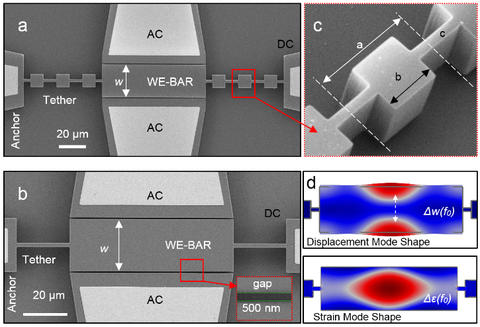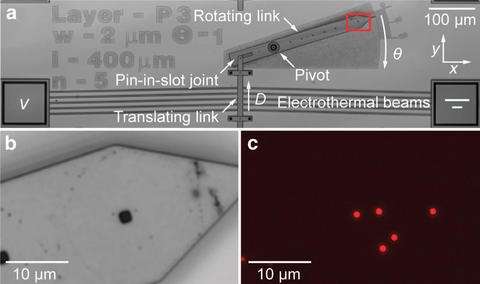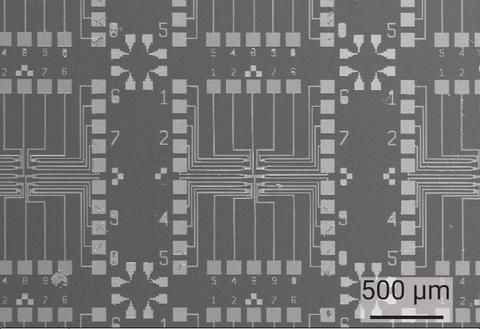Summary
Microelectromechanical systems (MEMS) are integrated devices with critical applications in sensing, timing, signal processing, and biomedical diagnostics, and have become ubiquitous in wireless communications, automobiles, aerospace systems, medical devices, and consumer products. This project advances measurement science for micro- and nanoelectromechanical systems (MEMS/NEMS) with a focus on innovations that will enable future generations of MEMS/NEMS.
Description

A micromechanical bulk acoustic resonator that uses phononic crystal tethers to achieve a quality factor approaching the fundamental dissipation limit (fxQ can be as large as 1.2 x 1013 Hz)
MEMS/NEMS are enabling technologies that bring new functionalities with the potential to radically transform markets ranging from consumer products to national defense. The meteoric rise of the smartphone is an excellent example, in which MEMS accelerometers, gyroscopes, microphones, displays, and RF filters and oscillators provide functionality that has made the most sophisticated mobile phone from a decade ago look like a relic. The MEMS industry is expected to continue to grow quickly, particularly due to the establishment of the Internet of Things, which requires ubiquitous sensing, computing, and communications. This project is focused on innovations in measurement science that will enable future generations of MEMS/NEMS. This is achieved by:
- Developing advanced measurement tools and methods for MEMS/NEMS
- Using these tools and methods to investigate MEMS/NEMS device physics, particularly with respect to performance limitations in sensors
- Developing traceable MEMS/NEMS sensors for precision measurements at NIST and beyond
- Leadership in the development of metrology standards for MEMS/NEMS

Due to the enormous diversity of devices found in this field, the research topics covered by the project are selected to match with growth areas and to be well-positioned within the NIST mission. Our current research is largely in the following areas:
- Motion Metrology for MEMS/NEMS
- Micro- and Nanophotonic Sensors
- Radio Frequency MEMS/NEMS for Sensing and Timing
- BioMEMS and Microfluidics
- Optical and Electronic Biosensing
- Wafer Bond Metrology
Major Accomplishments
2017
- Achieved fundamentally limited fxQ (as high as 1.2 x 1013 Hz) in a silicon micromechanical resonator using phononic crystal tethers
2016
- Developed the theory of localization microscopy for motion measurement of MEMS, where constellations of fluorescent particles are tracked to attain 3D motion
- Demonstrated MoS2 field effect transistors using films grown with chemical vapor deposition. The technique will permit wafer-scale sensor fabrication for applications in precision medicine
- Published open-source software called MOSAIC (https://pages.nist.gov/mosaic) that is used to process data from label-free single molecule measurements made with nanopores

2015
- Designed and fabricated the components for a self-calibrating optomechanical accelerometer, including concave silicon micromirrors with better than λ/20 shape and 2 mg silicon proof masses suspended by silicon nitride flexures
- Demonstrated displacement interferometry on nanostructures with beam widths down to 100 nm and achieved 200 MHz bandwidth and resolution better than 150 fm/rt-Hz
- Extended the concept of localization precision in super-resolution fluorescence microscopy to centroid and orientation precision for moving rigid bodies with constellations of optical point sources and validated this approach through Monte Carlo simulations
- Developed a new optical method based on displacement sensing for measuring the nonlinear and nonconservative forces on optically trapped particles in air or vacuum, as well as other parameters, including particle diameter, oscillation frequency, gas viscosity and temperature
2014
- Performed a quantitative comparison of optical coherence tomography and laser scanning confocal microscopy for measuring the internal structure of microfluidic devices, particularly with respect to channel depth, width, and shape
- Developed a multilayer microfluidic device that reduces the critical distance between cells under test and the time for cell-cell interactions by a factor of 100 compared to traditional methods
- Led the development of five SEMI standards on through-silicon vias and wafer bonding as related to the fabrication of integrated circuits and MEMS (SEMI 3D5-0314, SEMI 3D8-0514, SEMI 3D9-0914, SEMI 3D10-0814, SEMI 3D11-1214)
2013
- Developed a new measurement technique for measuring the quasi-static motion of MEMS based on super-resolution fluorescence microscopy, resulting in a localization precision of 0.13 nm
- Demonstrated the dielectrophoretic trapping of cells on adhesive-coated polyester membranes that support cell growth for long-term studies (weeks) on cell-cell communication and motility
- Released an updated user's guide for the MEMS 5-in-1 reference materials (RM 8096 and 8097) including detailed information on the prescribed measurement procedures and uncertainty analysis for Young's modulus, residual strain, strain gradient, step height, in-plane length, residual stress, stress gradient, and thickness

